Albany, New York Crime Maps
Article published May, 2025.
Where is crime happening?
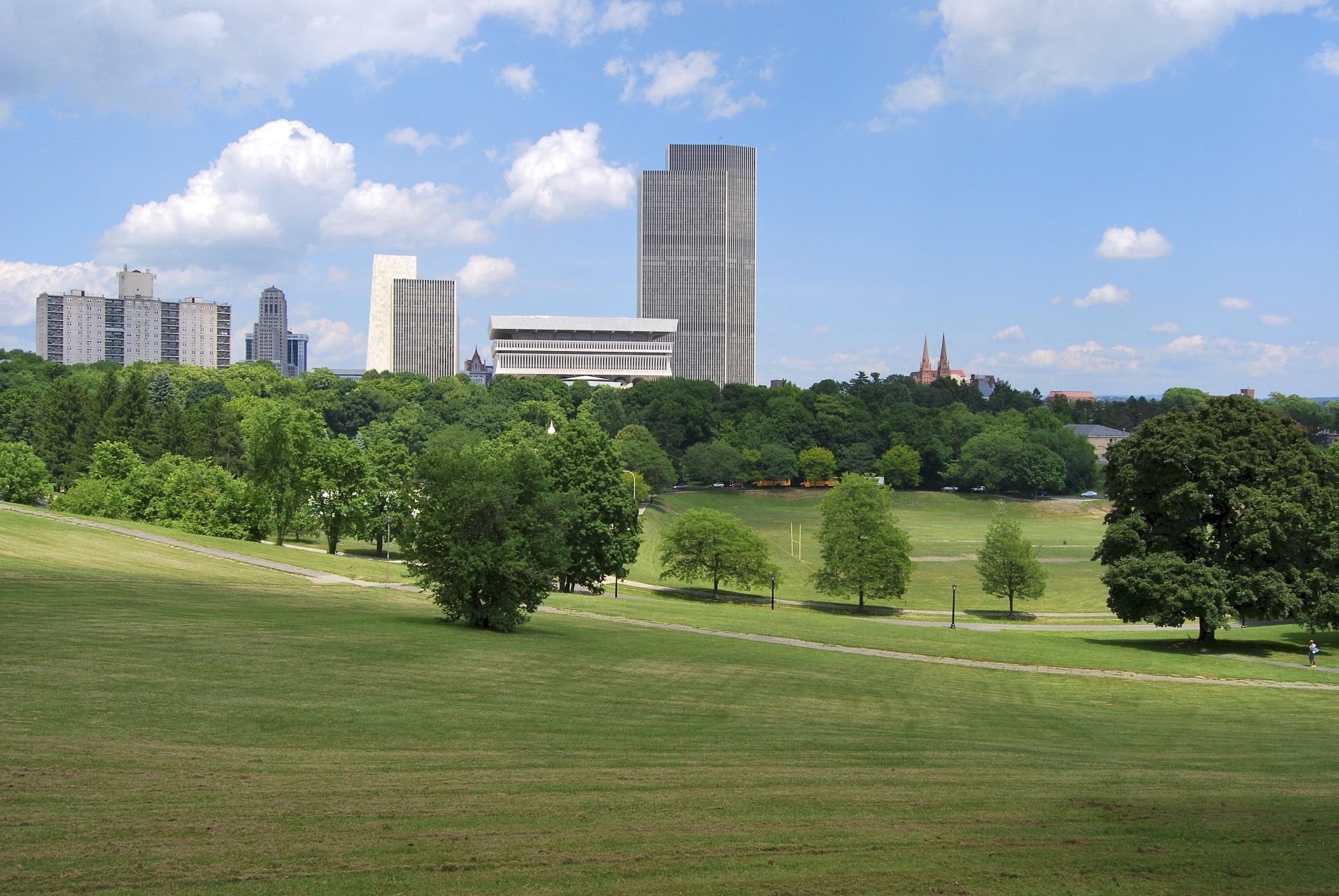
An Independent Look at Albany Crime Data: Part 2
Note - This is the second of a multi-part article on Albany's Crime. In Part 1, we focused on the overall crime trends in Albany. Part 2 of this series focuses on OUTSIDE crime throughout Albany. Part 3 will look at INSIDE crimes at domestic locations and businesses.
In our analysis below, we come to several directional statements:
1. The highest density of reported crimes that were categorized as OUTSIDE occurs along the Central Ave corridor from Lark St to Partridge St, extending SW along Washington Ave and NE along Clinton Ave. Areas around South Pearl and the Delaware and Second Ave/Whitehall intersection also stood out.
2. Separating crimes under the THEFT and VIOLENCE categories shows that crimes tend to fall under the THEFT category as crime density decreases.
3. THEFT crimes were further split into crimes related to CARS and NOT CARS, which showed these were the most common crimes in areas where crime density was low.
4. The HOT and COLD months have different crime trends, however they seem to show that the rate of occurrence differs, but not the location.
In our article below we will show maps that highlight areas with high and low crime. Importantly, we can say what we are NOT trying to do with these maps - we're not trying to marginalize, deride or shame any particular neighborhood. What we DO believe is that highlighting where crime does and doesn't happen is an important step towards developing policies that make streets safer for everyone.
Analysis Overview
In Part 1, we analyzed the 78,094 incidents reported between Jan. 1st, 2020, through Mar. 8th, 2025, and whittled them down by first eliminating incidents labeled as NO CRIME and ALL OTHER. We grouped the crime data by month, and a pattern emerged that showed a cyclical increase of crime during summer months. This led us to further filter the crime data by location type, grouping several of these into a broad category to cover crimes occurring OUTSIDE.
As a reminder, every incident comes with a Location Type. The following Location Types were collectively classified as OUTSIDE - STREET, PARKING LOT, YARD, OTHER OUTSIDE LOCATION, GAS STATION, AUTO SALES LOT, FIELD WOODS, CONSTRUCTION SITE, PARK PLAYGROUND, LAKE WATERWAY, CEMETERY.
Part 1 concluded by showing an increase in VIOLENCE occurring during warmer months and a drop in colder months. As a reminder, heading into this story, OUTSIDE crimes listed under UNIFORM CRIME REPORT were split into three categories - THEFT, VIOLENCE, and OTHER (consisting of all remaining crimes without a clear distinction between theft or violence).
We found that our division of crimes was mostly inline with the grouping the FBI uses to denote these crimes, except the FBI's labelings are Crimes Against Persons, Crimes Against Property, and Crimes Against Society instead of VIOLENCE, THEFT, and OTHER, respectively. We’ve decided to update our terminology to PERSONS, PROPERTY, and SOCIETY to be more consistent with the FBI’s UCR.
| PERSONS
(Crimes Against Persons) |
PROPERTY
(Crimes Against Property) |
SOCIETY
(Crimes Against Society) |
|---|---|---|
| Simple Assault | Larceny | Criminal Mischief |
| Aggravated Assault | MC Larceny | Controlled Substances |
| Murder | Stolen Property | Dangerous Weapons |
| Sex Offenses | Burglary | Disorderly Conduct |
| Kidnapping | Robbery | Offenses Against Family |
| Rape | Embezzlement | Offenses Against Public Order |
| Coercion * | Fraud | GCO |
| Forgery | DWI | |
| Unauthorized Use | Gambling | |
| Extortion | Possession of Burglary Tools | |
| Arson * | Prostitution |
Note (*) - COERCION and ARSON were placed in PERSONS and PROPERTY respectively to be more consistent with the FBI's UCR.
Mapping crime & Neighborhood analysis
We introduced a new dimension to our analysis, we geocoded or mapped crime locations using the values from HUNDRED BLOCK. From there, we were able to place crimes in different neighborhoods throughout Albany. The first thing we checked was the total number of crimes for each neighborhood. Below is the breakdown listing the total number of crimes, number of Larcenies (sum of LARCENY and MV LARCENY), CRIMINAL MISCHIEF, and assaults (sum of SIMPLE ASSAULT and AGGRAVATED ASSAULT).
Note that we are using neighborhood boundaries derived from a dataset created by Zillow. This dataset was originally incomplete and did not cover the complete surface of Albany, so we added a few definitions for several missing neighborhoods. We also want to remind everyone that, while some neighborhoods may show more crimes than others, no other factor was considered, such as neighborhood size, population density, estimates on housing prices, property taxes, etc.
In our maps below we will focus on three areas of the city. To avoid ambiguity we are calling these mapping areas:
"Central Albany" - the area around Washington Park and north
"Southern Albany" - the area around Lincoln Park and south
"Western Albany" - the area west of Main Street
| Neighborhood | Total Number of Outside Crimes | Number of Reported Larcenies | Number of Reported Criminal Mischief | Number of Reported Assaults |
|---|---|---|---|---|
| Arbor Hill | 738 | 251 | 216 | 142 |
| Bishop s Gate | 146 | 81 | 22 | 22 |
| Buckingham Lake - Crestwood | 123 | 85 | 19 | 6 |
| Campus Area (University District) | 177 | 114 | 33 | 17 |
| Center Square | 188 | 103 | 44 | 25 |
| Central Ave | 653 | 232 | 173 | 143 |
| Colleges | 170 | 59 | 53 | 38 |
| Delaware Ave | 570 | 266 | 151 | 84 |
| Downtown | 478 | 192 | 130 | 93 |
| Dunes | 94 | 56 | 25 | 8 |
| Helderburg | 88 | 58 | 19 | 7 |
| Hudson/Park | 235 | 101 | 72 | 33 |
| Kenwood and Normasville | 140 | 78 | 32 | 12 |
| Krank Park - Cherry Hill | 100 | 30 | 33 | 26 |
| Mansion Area | 310 | 135 | 59 | 55 |
| Melrose | 90 | 57 | 17 | 7 |
| New Scotland | 167 | 97 | 27 | 20 |
| North Albany - Shaker Park | 174 | 74 | 41 | 23 |
| Park South | 293 | 143 | 64 | 59 |
| Pine Hills | 1491 | 723 | 281 | 248 |
| Second Ave | 124 | 42 | 40 | 15 |
| Sheridan Hollow | 356 | 121 | 108 | 71 |
| South End | 704 | 225 | 172 | 190 |
| Upper Washington Ave | 742 | 372 | 147 | 118 |
| Warehouse District | 156 | 67 | 46 | 24 |
| West Albany | 217 | 109 | 41 | 35 |
| West Hill | 1716 | 545 | 322 | 413 |
All Outside Crimes in Albany
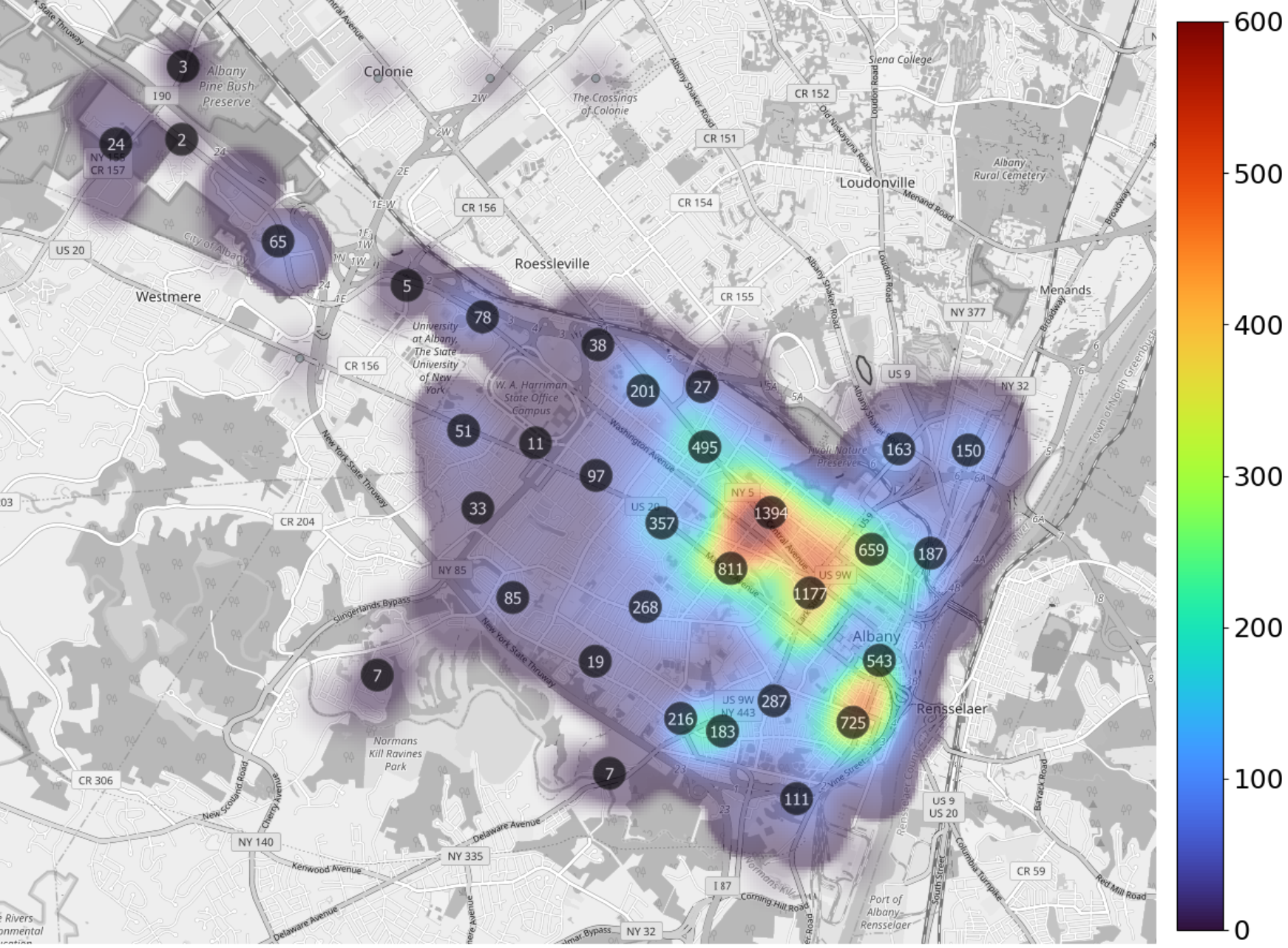
In all crime maps we are using heatmaps which are a great mapping tool for understanding dense point data. Heatmaps are an interpolation technique that is useful in determining density of input features. Heatmaps are most commonly used to visualize crime data, traffic incidents, housing density etc. To begin we generated a heatmap of OUTSIDE crimes which then lets us understand broadly where crime happens.
Outside Crimes Around Central Albany

Our next map shows a zoomed-in view of the high crime concentration in areas that surround Washington Park. This was the area that seemed to have the highest concentration of reported crimes. The number of OUTSIDE crimes is represented in each marker.
In the next 3 maps we display the number of crimes classified under PROPERTY and PERSONS.
Outside Crimes Central Albany - Property vs Person
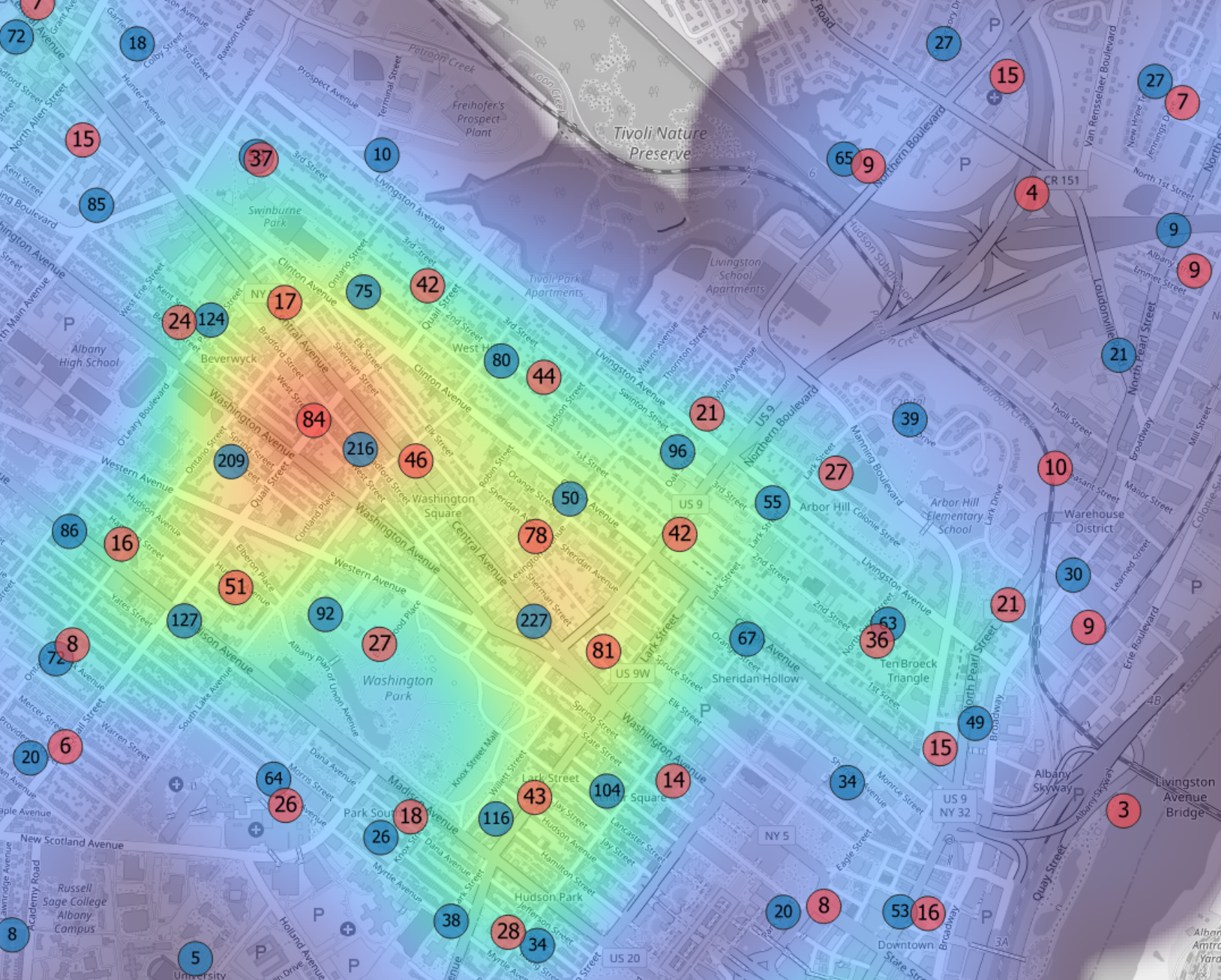
For Central Albany we have a zoomed-in heatmap generated from all OUTSIDE crimes reported in the greater Washington Park area. The blue markers show crimes categorized under PROPERTY, and red markers showing crimes categorized under PERSONS.
Outside Crimes Southern Albany - Property vs Person

For South Albany we have a zoomed-in heatmap generated from all OUTSIDE crimes reported in South Albany, along Delaware Avenue and South Pearl Street. The blue markers show crimes categorized under PROPERTY, and red markers showing crimes categorized under PERSONS.
Outside Crimes Western Albany - Property vs Person
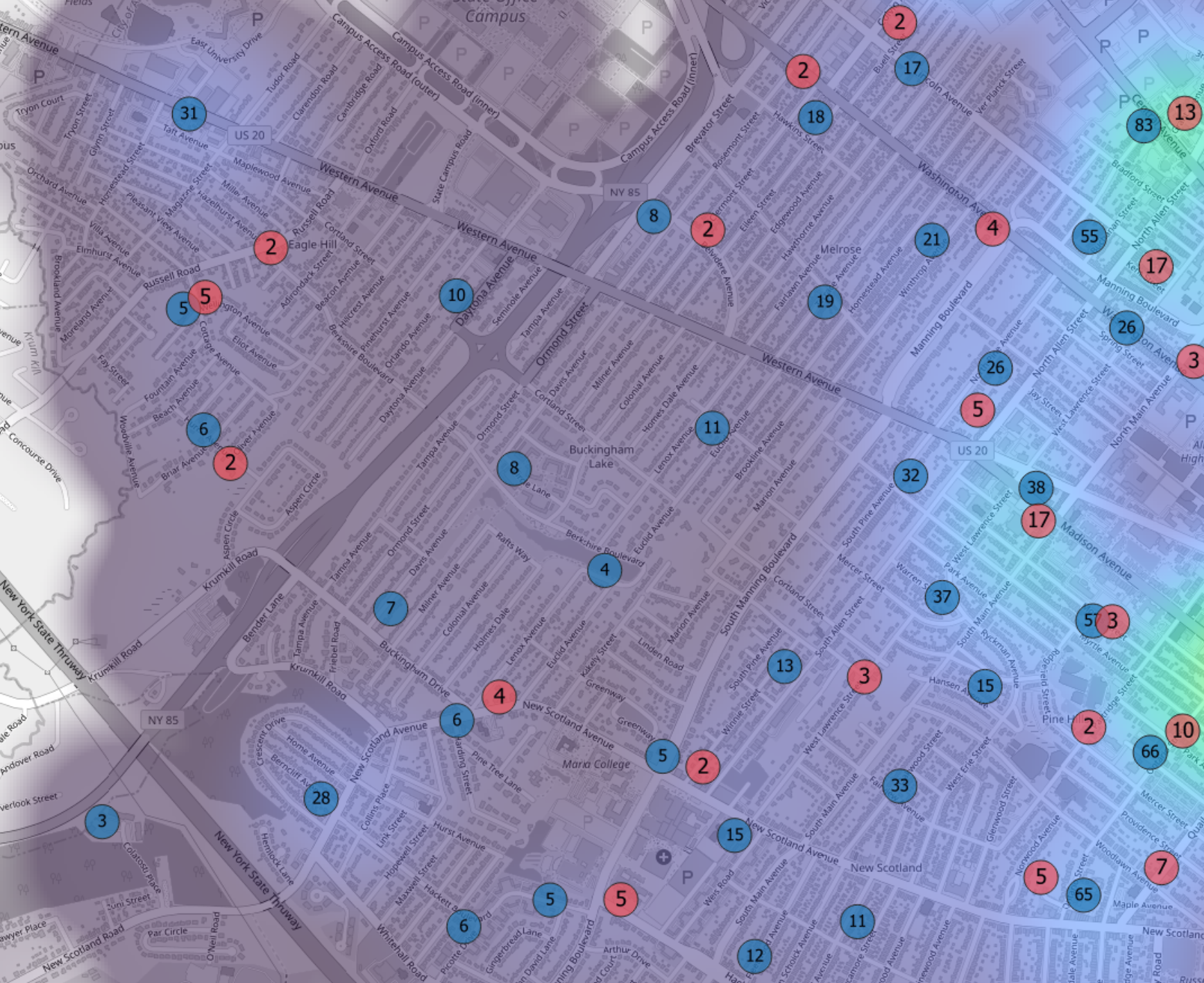
For Western Albany we have a zoomed-in heatmap generated from all OUTSIDE crimes reported in the areas of Whitehall Road, Hackett Boulevard, South Manning, Buckingham Pond, Eagle Point, and a part of Pine Hills.
The blue markers show crimes categorized under PROPERTY, and red markers showing crimes categorized under PERSONS.
Outside Property Crimes Western Albany - Cars vs Not Cars

In West Albany, there are significantly fewer PERSONS crimes relative to other areas of the City. This led us to further examine the types of PROPERTY crimes occurring in West Albany. To do this, we used the CRIME CLASSIFICATION column to split PROPERTY crimes into thefts related to cars (CARS, 3,334 total crimes) and those that were not (NOT CARS, 2,185 total crimes). In this figure, yellow markers show CARS crimes and green markers show NOT CARS crimes.
Outside Property Crimes - Criminal mischief
In the table at the beginning of this article we explained the grouping of crimes into PERSONS, PROPERTY and SOCIETY dimensions.
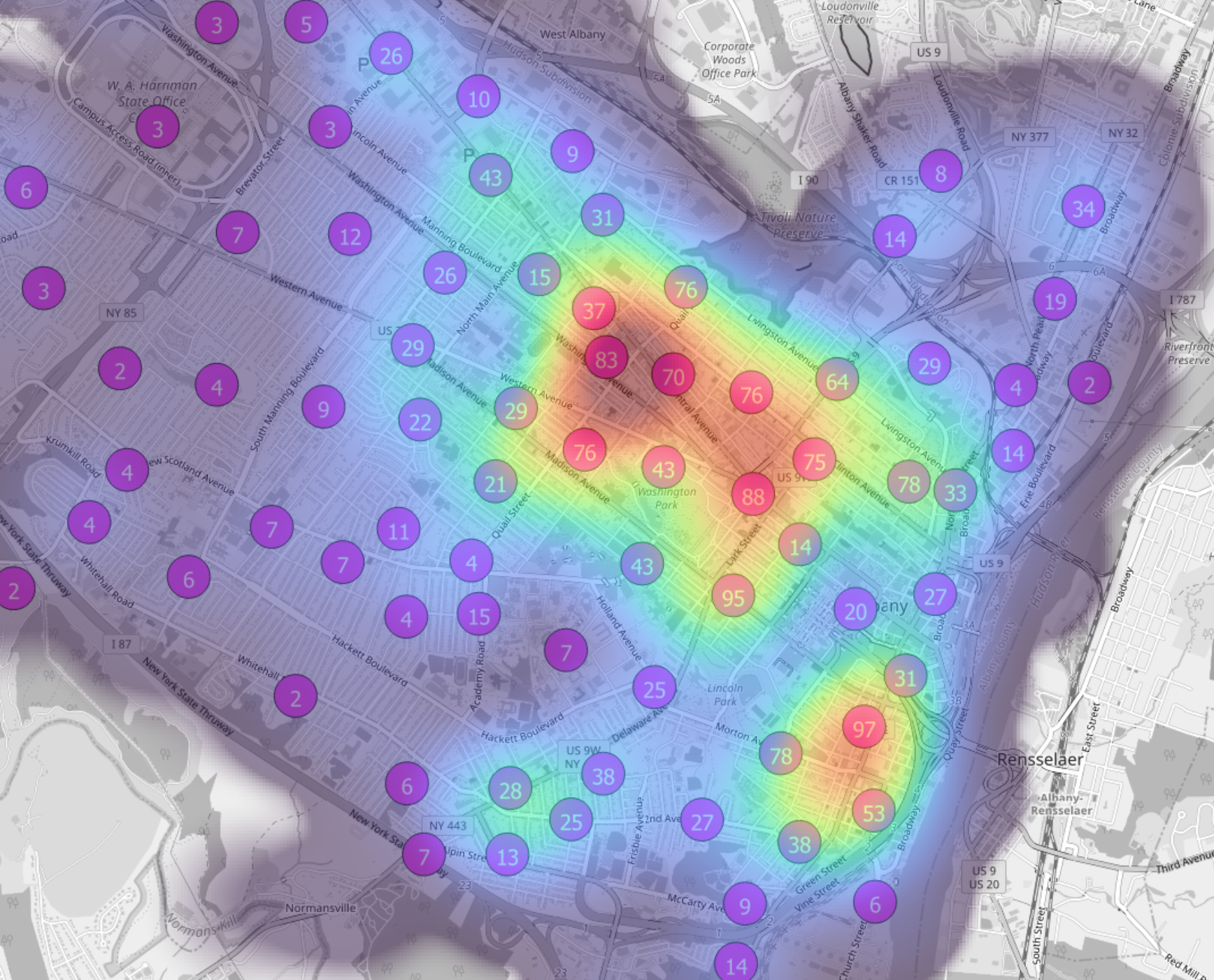
This sparked our curiosity into CRIMINAL MISCHIEF (a SOCIETY crime) and where these incidents happen. This heatmap maps the locations of CRIMINAL MISCHIEF; these crimes are consistent with other locations where there were a lot of crimes occurring.
The number of CRIMINAL MISCHIEF crimes are displayed in the purple circles
Outside Property Crimes - Hot vs Cold Months
Lastly, as noted in Part 1, the number of OUTSIDE crimes reported under PERSONS varied between warmer and cooler months. We split these crimes into two categories, COLD (October - March) and HOT (April - September), and present that information overlaid on a heatmap. Generally HOT months have 60-70% more OUTSIDE crimes than COLD months.
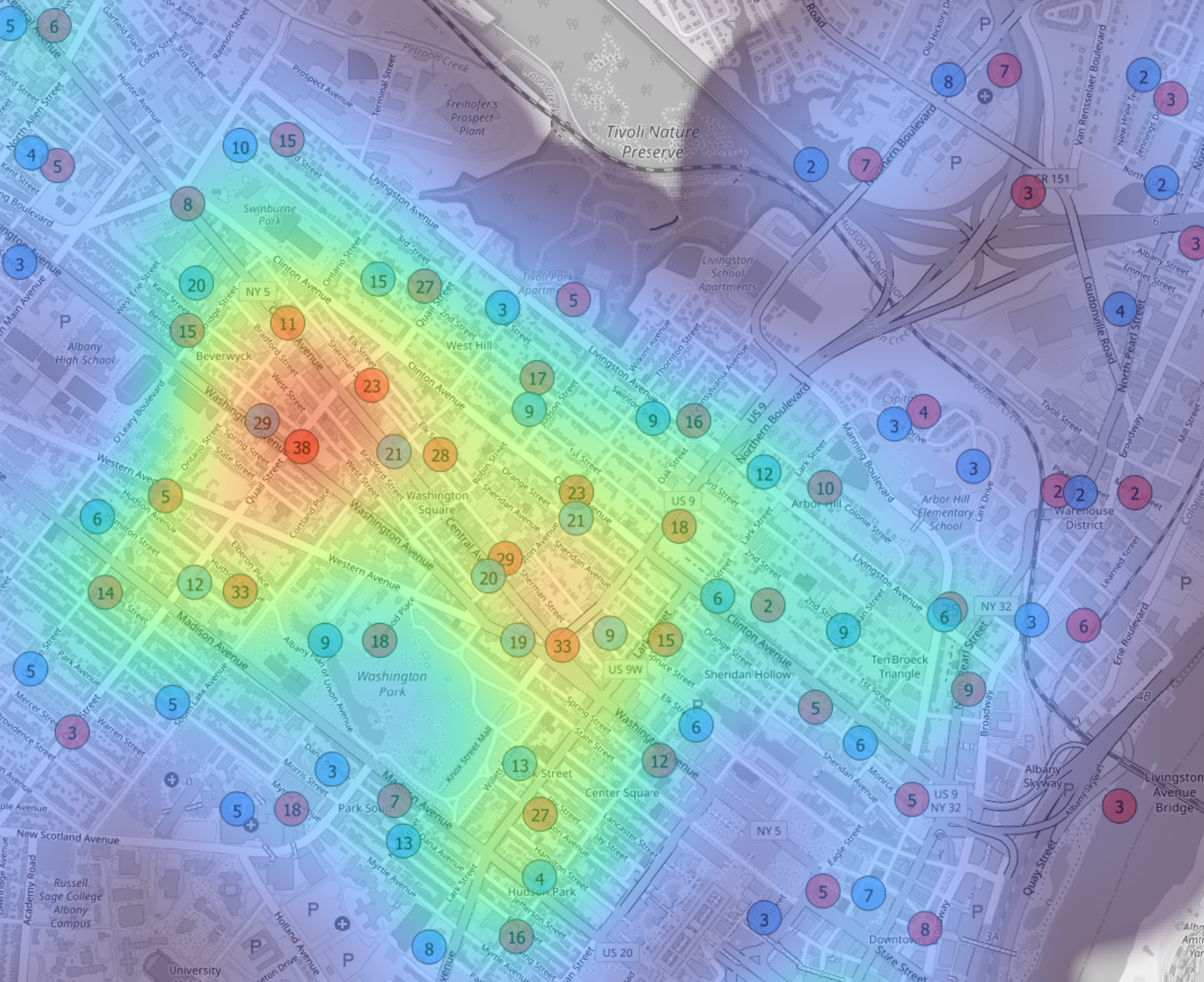
Central Albany heatmap with all crimes classified under PERSONS split between COLD and HOT represented in the blue and red markers, respectively.

Southern Albany area heatmap with all crimes classified under PERSONS split between COLD and HOT represented in the blue and red markers, respectively.
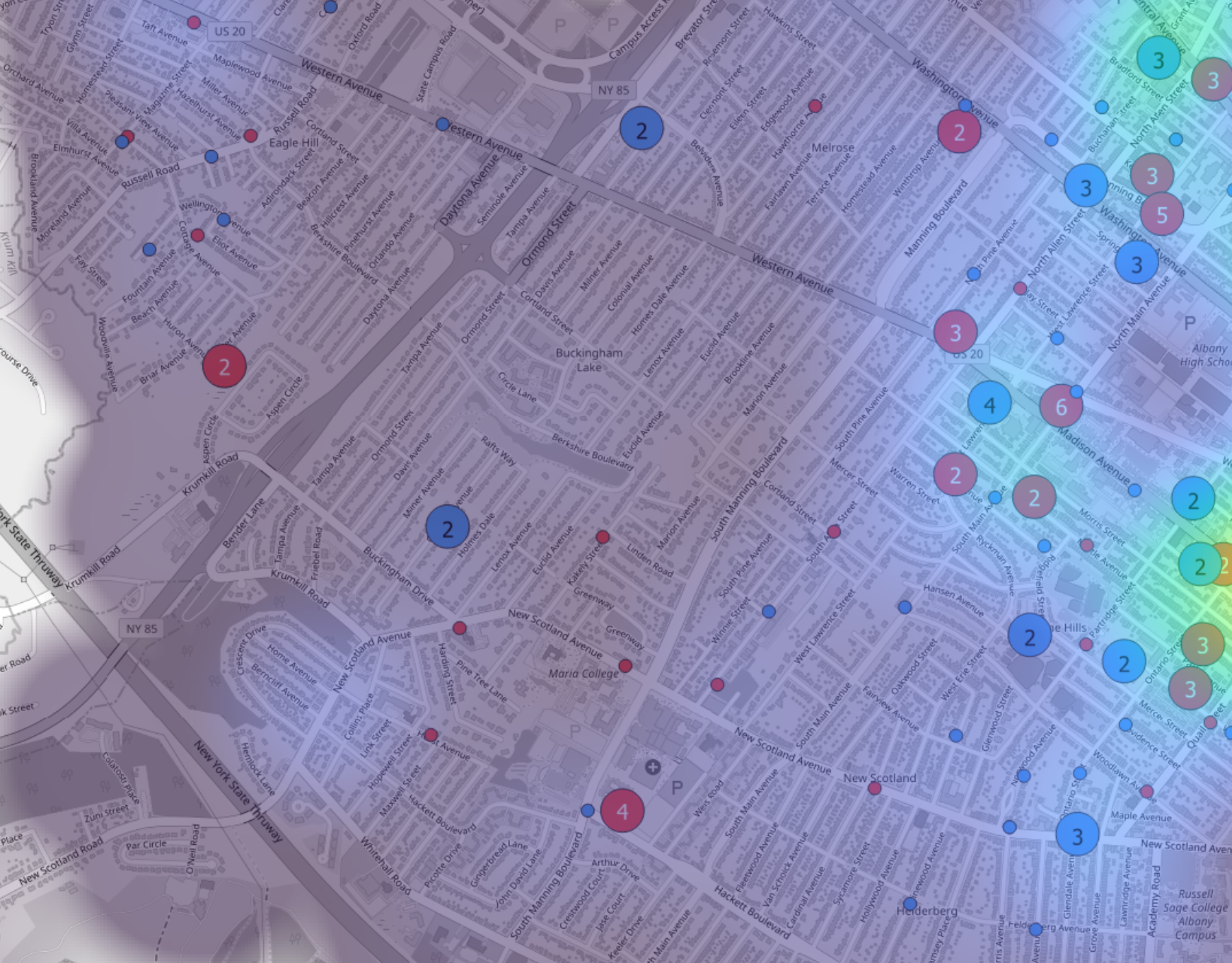
Western Albany area heatmap with all crimes classified under PERSONS split between COLD and HOT represented in the blue and red markers, respectively.
Download the original crime data
Download the original data obtained through Freedom of Information Law (FOIL)
The details of the data can be found here.
Process
Part 1 of the Crime article outlines the processes used to prepare the data obtained under FOIL from the City of Albany.
Following up on APD Crime reports part 1
We also want to thank everyone who reached out and provided tips, hints, and constructive criticism via email, Reddit and other channels on Part 1 of our story.
To elaborate on a few questions and comments we received:
- We were informed that incidents marked as NO CRIME cover a broad range of things. These can be anything from someone wanting to bring something to the attention of APD to capturing an event resulting in an injury to an officer.
- We received a question about what MISC includes. MISC includes - Fraud (642), Rape (356), Sex Offence (286), Unauthorized Use (205), Controlled Substances (166), Stolen Property (139), Kidnapping (87), Murder (84), Forgery (78), Arson (68), Disorderly Conduct (37), GCO (35), Extortion (33), DWI (18), Offenses Against Public Order (8), Offenses Against Family (7), Embezzlement (3), Coercion (2), Prostitution (1), Poss of Burglary Tools (1), Gambling (1)
- We haven’t had time to pull in additional data, i.e., employment rate, active duty police officers, etc. These are items we are considering in future studies involving crime data. For now, we’re concentrating on mining the single source of data to showcase the value contained in the dataset. We are interested in bringing in additional datasets, but we want to be very selective in the ones we bring in and make sure that we capture as much detail as possible. For example, in addition to the total number of active duty police officers, we’d likely want to know the distribution of their years of service, the precinct they are assigned to.
- We are still working with the same data Jan 1st, 2020 - March 2025, and have not had an opportunity to request data before 2020. This is something we are discussing.
- Finally, above in the Data section we have included a link the source data. We’re excited to share this with you, and all we’re asking is that if you use the data, please provide a link back to Albany Data Stories. If you’re interested in writing an article of your own using this and other data, please reach out at albanydatastories@gmail.com.
Next - in part 3
Our aim for Part 3 will be to examine crime that occurs at indoor locations, both in domestic settings and in businesses. That analysis will incorporate a lot of the elements that we’ve introduced in Parts 1 and 2, including time-series analysis, heatmaps, and maybe even a pie chart with less than 6 fields!
Have questions or comments on either Part 1 or Part 2? Email us at albanydatastories@gmail.com
Wonder what data stories we are working on next? See our current queue here! We are always looking for people to suggest additional stories and people who want to assist with any data analysis and authoring.
Credits
This data story and its content is available under the Creative Commons Attribution license.
Persons or organizations that Share or Adapt this content should provide Attribution that provides appropriate credit, which includes:
- © Copyright 2025
- Tyche Insights, P.B.C.
- AdamTyche
- KarlTyche (Karl Urich)
- KeithTyche
For example, a data product or service that utilizes this article could include attribution such as:
"Portions derived from 'Albany NY Crime', © Copyright 2025 by Tyche Insights, P.B.C., AdamTyche, KarlTyche (Karl Urich), KeithTyche & licensed under the CC BY 4.0 license"